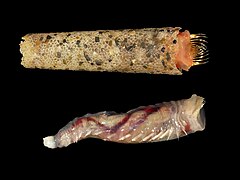Pectinariidae
| Pectinariidae Temporal range: Cretaceous–Holocene |
|
|---|---|
 |
|
|
Lagis koreni inside and out of its tube. Head is to the right. |
|
| Scientific classification | |
| Kingdom: | Animalia |
| Phylum: | Annelida |
| Class: | Polychaeta |
| Subclass: | Canalipalpata |
| Order: | Terebellida |
| Family: |
Pectinariidae Quatrefages, 1866 |
| Genera | |
|
2-5, see text. |
|
2-5, see text.
Pectinariidae, or the trumpet worms or ice cream cone worms, are a family of marine polychaete worms that build tubes using grains of sand roughly resembling ice cream cones or trumpets. These structures can be up to 5 centimetres (2 in) long. The earliest pectinariid fossils are known from the Cretaceous.
Pectinariids are sessile burrowing tube dwellers, which can be found in fine-grained sediment. They position the wider end of their tube downwards, and use their stout golden setae for digging while they use tentacles for sorting the particles which they ingest. Half of the particles which the worm digs through are excreted as pseudofaeces.
The systematics of the pectinariids have been the subject of some debate. Previously, only two genera have been recognized, but three subgenera have been elevated to full genera by some scholars.
...
Wikipedia
